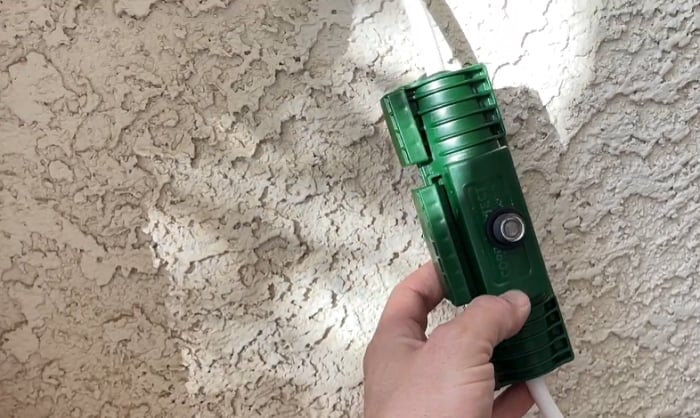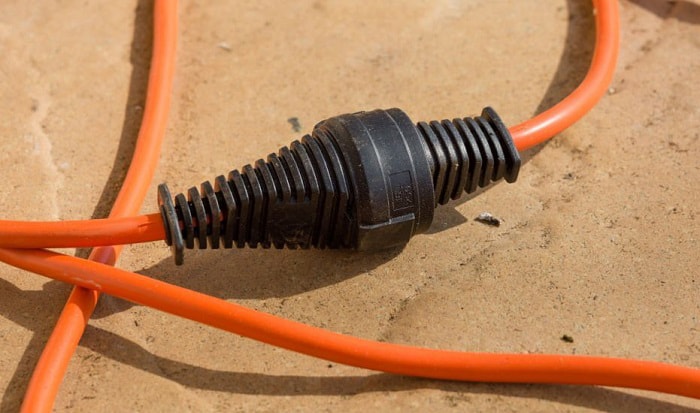Extension cords are beneficial for different outdoor activities and decorations that require electricity. You can use them for power tools or for outdoor lighting far away from your electrical outlet.
If you frequently use an extension cord in your backyard, it makes sense to conceal it. However, safely hiding your cables is not an easy task.
To learn how to hide outdoor extension cords in different ways, you can read below.
Table of Contents
Ways to Hide Outdoor Extension Cords
There are a lot of ideas for hiding cords outside your house. Some of these will surely cost you a lot, but in return, they will benefit you for a long time. In simple words, different methods require different tools and different price points.
A hidden outdoor extension cord will keep your outdoor area looking clean and safe. Here are the different methods that you can use to hide your electrical cords outside your house.
1. Use a Conduit to Hide Your Extension Cord
Using a conduit and a c-clamp, you can run your cord around the outside walls and siding of your house. You can also run it through garden borders, fences, and other decorations in your garden.
There are two easy ways to feed your cord into the conduit. One uses a metal fish tape puller, and the other uses a conduit piston, a pulling wire, and a vacuum cleaner.
Guide for Pulling the Cord into the Conduit
- Using a metal fish tape puller
For the fish tape, you only need to feed it into the conduit, wrap the wire to the hook of the fish tape, and pull the fish tape.
- Using a conduit piston and pulling line
If you are going to use a conduit piston, you first need to tie it with the pulling wire and insert it into one end of the conduit.
On the other side of the conduit, you can tape the vacuum nozzle and turn the vacuum on. After sucking the piston to the other side of the conduit, you can now remove the piston.
Though this will cost you a hefty sum of money, using a conduit to hide extension cords outside is ideal for a long-term investment. It is because it can protect the cord from harmful weather and animal bites.
However, to be able to insert the cord into the conduit, you may need to disassemble one side of your extension cord.
2. Use Plants or Grass to Hide Extension Cords
Aside from using a conduit, you can place the cords directly on the side of your walking path or wall. You can hide the cord using different plants and other decorations, such as stones of different sizes and colors or in the grass.
With this method, you can hide your cords while making your outdoors look nice and organized.
If you worry about tripping hazards, a cable ramp would be a big help. You just need to cut it to your needed length, fix it to the ground, and put your cord into it.
3. Install it Underground
The best way to hide your extension cord outside is to install it underground. This method is mainly used as a long-time solution for external electricity needs.
Using a PVC ribbed tube to conceal outdoor extension cords can prolong their lifespan. Moreover, an outlet cover or plug cover is also needed in this application to have a weatherproof connection.
Additionally, since you need to install your extension cord into the ground, you may need a trenching tool.
Interested in installing your extension cord underground? Here is the guide on how to do it properly.
Step 1. Put Your Outlet Into the Weatherproof Box
If you want to set up two or more outlets for your outdoor electrical connection, you must assemble them first. For example, you may want to install two pieces of two gang outlets.
In this case, you first need to make a bridge connection between the two. After that, connect the input wire for the electrical connection to one outlet. Then, put the assembly into your weatherproof box.
You may not need to do this if you only need a single outlet for your electrical connection outside. However, you may need an electrical plug cover to secure your connection.
Once you have done this process, you can proceed to the next one.
Step 2. Mount the Receptacle and Dig a Channel for Your Cords
After building your outlet, you can place it in the location of your choice. However, you must ensure that the length of the cord is sufficient to reach your installation location and your outdoor outlet.
Next, using your trench tool, dig at least an 8 to 10-inch deep channel. After digging, insert the cord into the conduit, then into your created channel.
Step 3. Clean the Area and Test Your Work
After your work, you should clean the area. But, before doing so, you should also test your setup to make sure that it is working.
Plug your extension cord into your outdoor receptacle and turn on your garden lighting or any appliance you want to use outside.
The buried extension cord will have some protection from different elements that can damage it.
Note: This method can be expensive. Aside from the expenses for the tools, you also need to add some budget for the repair of the channel you made, especially if you have concrete ground.
Tips for a Better Cord Management
- If you use two or more electrical connections for patio lights, using an outdoor cord box to organize them is a brilliant idea. It provides tangle-free cords and keeps your electrical connections in good condition.
- You can tape down extension cords outside and hide them using the above method. This way, you can hide outdoor string light cords and insulate them.
FAQs
Why Do You Need to Hide Extension Cords in the Patio?
It is ideal for many of us to hide our electrical connections for Christmas lighting or other appliances to have a safe environment.
Otherwise, an exposed part of the extension cord might get damaged by animal bites or harsh weather conditions. As a result, it can cause electrocution to someone accidentally stepping on it or an electrical fire.
It is also important to know that it is not suggested to put cords in an airtight container. The container might trap heat inside, creating a fire hazard.
How Do You Waterproof Outdoor Extension Cords?
There are many ways to waterproof extension cords. Some may cost you a lot of money since you must purchase premium tools such as a conduit, plug cover, or waterproofing gasket.
But you can also use a DIY waterproof outdoor extension cord cover to save money, especially if you are tight on budget. Some examples are cling wraps, buckets, and plastic bottles.
You can use cling wraps to wrap the cord, especially the connected lines to make them waterproof. Alternatively, you can also put your electrical connections inside buckets and plastic bottles to prevent them from getting wet.
Related:
- How to Know If Your Extension Cord is for Outdoor Use
- Ways to Protect Outdoor Extension Cord from Rain
Conclusion
Hiding an outdoor extension cord does not only improve the appearance of your surroundings. It can also prevent electrical hazards caused by an unpredictable environment and animal damage.
You can choose one of the above methods on how to hide outdoor extension cords. Meanwhile, do you have any ideas on this topic? Share them with us by writing in the comment section below.

I am Andrew Wright. With 8 years of experience designing, installing, and maintaining electrical power systems. I love my job, and I have always wanted to offer others the necessary help so they can take care of their houses.



